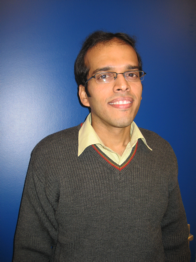Micromachined dense palladium electrodes for thin-film solid acid fuel cells
Promotion date: 10. December 2009
Promotor: Prof. Dr. Miko Elwenspoek
Assistant Promotor: Dr. Ir. Henri Jansen
| This thesis paves the way towards the microfabrication of a solid acid electrolyte based fuel cell (µSAFC), which has a membrane electrolyte assembly (MEA), consisting of a thin-film of water soluble electrolyte, encapsulated between two dense palladium electrode membranes. The project focuses on electrode fabrication and characterization. Microfabrication techniques to realize the dense palladium membranes are investigated, as is their suitability as hydrogen diffusive electrodes. One µm thick palladium membranes, on perforated silicon gas diffusive supports (a microsieve), are fabricated. The membranes show a good permeate flux and a good selectivity for hydrogen. The embrittlement, happening in the presence of hydrogen at lower temperatures, is thoroughly studied. |
Can you mention some interesting aspects of this specific fuel cell, and the way you studied it?
The fuel cell functions at relatively low temperatures. The new electrolyte was introduced by Caltech in 2001. The idea to use dense electrodes, permeable by H2 only, is a new one, on which my project is based. In this STW-project another thesis-student works, on describing and developing the electrolyte layer.
Using micromachining techniques, thin electrodes are possible, varying between 200 nm – 1 µm. By supporting them on a silicon microsieve, I was able to successfully characterize the permeability and flux of these fragile membranes.
However, we noticed a fundamental problem when grains of palladium deform when H2 passes. Nevertheless, we could define a good process-window for the fuel cell to function: between 150 – 250 degrees Celsius. In this window, direct and free proton hopping through the electrolyte, typical for this kind of fuel cell, takes place in an effective and non-destructive manner.
What next steps are necessary to make the fuel cell more attractive?
In a post-doc year, I hope to actually build a fuel cell, using the theoretical and experimental findings discovered until now. Still some experiments have to be carried out, with regard to the electrodes and the electrolyte as well. The cell has to function at least 3000 hours without damage, to be commercially attractive.
What kind of researcher would you describe yourself to be?
My work should be of practical use, so I regard myself as an applied researcher. Nevertheless, fundamental issues might arise, and as I scientist that is never a problem but merely a challenge. It is of importance to understand the basics of this problem, but then again I am very practical. The challenge is to go and use the phenomena discovered, or to find an effective way to go around them.
Are you planning to stay active in the field of fuel cells in the future?
The thesis project resulted in four publications and two patents. One of these patents is about fabricating a carbon nanofiber based fuel cell electrode, which is applicable also in current state-of-art polymer electrolyte fuel cells.
I am planning to start a spin-off company in which these findings play a central role. They are of value in the fuel cell market, because presently the lifespan of electrodes is a problem. Perhaps I can contribute to the development with the new kind of electrodes. Also the findings of my thesis project, can contribute to products based on gas permeable membranes.
Isn’t is risky to start your own business at a relatively young age?
First of all, a lot of support seems to be possible, by STW, Kennispark Twente, and also Henri Jansen, my supervisor, is willing to help.
This makes it a good opportunity for a try. I believe in the concept, and also I am convinced that I can contribute to a valuable, environmental friendly technique, that is important in the future.
In the last four years I have grown as a scientist, being critical on content. For market opportunities one has to put in personal and social skills, to be successful. To do it myself, I can give it the best try possible. And, if I fail, I have a good story when I am applying for a job elsewhere. So, I am optimistic and hope not to face big problems.

